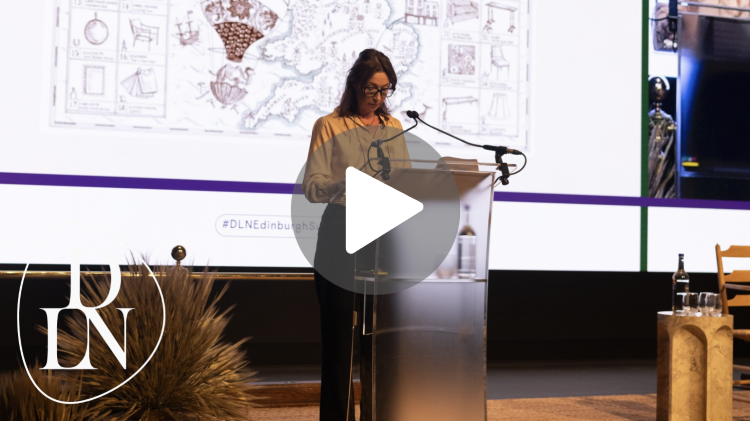If the world of design and architecture wants a bright future, it must look to the past. That’s the message Lulu Lytle, OBE, shared in her stirring session at the 2024 Design Leadership Summit in Edinburgh, where she delivered an urgent call for the creative industry to commit to the protection of craft skills and the culture of craftsmanship. From the stage at McEwan Hall, Lulu called on her fellow creative leaders to pick up the mantel of preservation, ensuring specialty techniques and skills survive for a new generation––and the good of the whole design industry.
The setting for Lulu’s talk could not have been more apt: Under the dome of Sir Robert Anderson’s 1897 grand hall, with William Palin’s frescoes in the Renaissance style gracing the ceiling above detailed plaster and gilt work, Lulu—who was honored earlier this year in the King’s Birthday Honours for her efforts to preserve British craft heritage—made the case for the value of such aesthetic and cultural wonders.
It’s a cause which the Soane Britain founder knows intimately: The handmade rattan furniture for which her company is now known is the result of Lulu’s own intervention in a skill that might otherwise have been lost to history. In 2010, Lulu got word that the last remaining rattan weaving workshop in England was going into foreclosure. Instead of letting the sun go down on a studio that had produced furniture for the likes of the Titanic and Sir Edwin Lutyens’s British Embassy in Washington, DC, Lulu bought it. Since then, she has revived the skills practiced there, often hiring children—and even grandchildren—of Soane artisans to continue the legacies of their forebears. In 2016, Soane acquired a chair manufacturer headed for a similar fate, again ensuring the protection of endangered craft skills.
As inspiring as Soane’s story is, Lulu’s presentation in Edinburgh delivered this message with much more urgency, making use of case studies to demonstrate the imminent risk we face of losing our history if we don’t invest in the skills that created it. Citing the famous fires at Windsor Castle, Hampton Court, and, most famously, Notre Dame, Lulu underscored the increasing difficulty to find artisans to undertake these restorations. As one master craftsman notes about the decline in teaching of decorative and applied arts at the highest level: “They don’t build cathedrals anymore.
And well that may be true, these craft skills are still at the very heart of much of the luxury design industry. Beyond being beautiful, they are what give interiors, objects, and buildings a soul. “Every object tells a story,” says Lulu. “But the stories told by craftsman-made objects are better—more human.”
That’s not to say, though, that Lulu’s call is one for abandoning technology—in fact, far from it. “Some people think I am straightforwardly hostile to mass-production,” she says. “I’m not. Industrialization in factories rather than small workshops has brought benefits of every kind.” After all, she posits, “conservation and innovation make a great power couple.” Indeed, in nearly all of the examples she cited—all the way back to Joseph Paxton’s design for the Crystal Palace based on the size of newly-available glass panes—the handmade has a steady partner in the innovative.
And of course, even as separate concepts, there’s room for both: “I believe in IKEA and Hermes,” says Lulu. The key is enlisting full transparency to allow room for both to flourish. Lulu’s plea is for manufacturers, designers, and consumers alike to lean into the story of the handmade where it already exists; to extoll the virtue of the maker no matter where they are making the item, be it an atelier in Paris or a workroom in Beijing.
It’s also to recognize that the value of the handmade, beyond looks (or even “soul”) is practical, too: As Lulu says, “Craftsmen have a flexibility a factory doesn’t.” That means an ability to develop new techniques, create custom applications, and quickly adapt to new needs. In an industry that thrives on providing the unique and bespoke—and in an era fueled by an ever-present hunger for the new—what better argument could exist for ensuring the longevity of this creative tradition?
